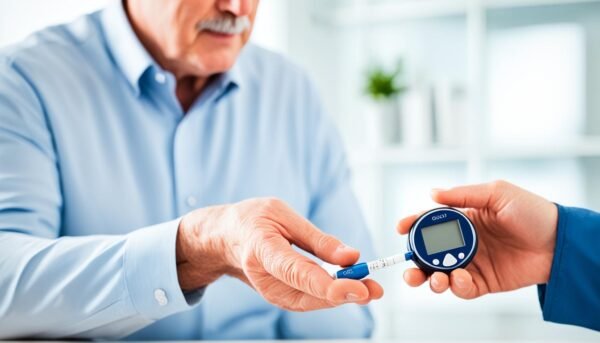As I sat in the doctor’s office, the news hit me hard. I had just been told I had type 2 diabetes. It was a shock, filled with fear and uncertainty. But I knew I had to take charge of my health.
The array of medications for type 2 diabetes was both overwhelming and promising. I learned about metformin, DPP-4 inhibitors, GLP-1 agonists, and SGLT2 inhibitors. Each one could help me manage my health in different ways.
Understanding these medications was key. I needed to find the right one for me. It was about lowering my blood sugar and tackling my specific health challenges.
Key Takeaways
- Type 2 diabetes can be managed through a variety of medication options, each with its own mechanism of action and benefits.
- Metformin is often the first-line medication, but newer classes like DPP-4 inhibitors, GLP-1 agonists, and SGLT2 inhibitors offer additional treatment options.
- Combination therapy, using multiple medications, can be a tailored approach to achieve optimal blood glucose control.
- Insulin therapy may be necessary in some cases, and it’s important to understand the different types and how they work.
- Lifestyle modifications, such as a healthy diet and regular exercise, are crucial components of a comprehensive type 2 diabetes management plan.
Understanding Type 2 Diabetes
Type 2 diabetes is a condition that affects millions globally. It’s important to know how to spot it early to manage it well. Let’s look into how type 2 diabetes is diagnosed and screened.
Diagnosis: The A1C Test
The A1C test is key for finding type 2 diabetes. It checks your blood sugar levels over the past 2-3 months. A level below 5.7% is normal, 5.7% to 6.4% means prediabetes, and 6.5% or higher confirms type 2 diabetes.
Additional Diagnostic Tests
Other tests like the random blood sugar test, fasting blood sugar test, and oral glucose tolerance test are used too. They help doctors understand your blood sugar levels accurately.
Screening: Who Needs It?
All adults 35 and up should get screened for type 2 diabetes. Younger adults who are heavy or inactive and have a family history of diabetes also need it.
| Risk Factors for Type 2 Diabetes |
|---|
|
Regular type 2 diabetes screening helps catch it early. This leads to better health and less risk of problems later.
“Proactive screening and early intervention are key to managing type 2 diabetes and preventing its long-term consequences.”
Metformin: The First-Line Treatment
Living with type 2 diabetes, I’ve learned how crucial metformin is for managing my health. Metformin, or Glucophage, is a key drug for type 2 diabetes. It helps by lowering the liver’s glucose production and making muscles more insulin-sensitive. This helps control my blood sugar levels.
Metformin is easy to take, just twice a day. But, some people might get diarrhea as a side effect. Eating with your medication can help lessen this issue, making it easier to manage.
| How Metformin Works | Side Effects of Metformin |
|---|---|
|
|
Being on metformin for type 2 diabetes has helped me manage my health well. Knowing how does metformin work and its side effects has made it easier to fit into my treatment plan.
“Metformin is the first-line medication for the treatment of type 2 diabetes, as it is effective, safe, and well-tolerated by most patients.”

The Benefits of Metformin
Metformin does more than just control blood sugar. It may also lower the risk of heart disease and stroke, which are common with type 2 diabetes. This is great news for those dealing with these health issues.
It can also help with weight loss, which is key for those with obesity or extra weight and type 2 diabetes. Adding metformin to a healthy diet and exercise plan can lead to better health overall.
DPP-4 Inhibitors: Enhancing Insulin Action
DPP-4 inhibitors are changing the game for type 2 diabetes treatment. They stop the breakdown of hormones like GLP-1 and GIP. These hormones help control blood sugar levels. By keeping these hormones active, DPP-4 inhibitors help manage blood sugar safely.
Popular DPP-4 Inhibitors on the Market
In the U.S., the following DPP-4 inhibitors are approved:
- Alogliptin (Nesina)
- Linagliptin (Tradjenta)
- Saxagliptin (Onglyza)
- Sitagliptin (Januvia)
These drugs help lower blood sugar without making you gain weight. They are also easy on the stomach, making them a top choice for many with type 2 diabetes.
Learning how DPP-4 inhibitors work helps people with type 2 diabetes pick the right medication. This way, they can work with their doctors for better blood sugar control.
“DPP-4 inhibitors have revolutionized type 2 diabetes treatment. They offer a safe, effective way to control blood sugar without weight gain or low blood sugar.”
GLP-1 and Dual GLP-1/GIP Receptor Agonists
GLP-1 agonists and GLP-1/GIP receptor agonists are key in managing type 2 diabetes. They work like natural hormones GLP-1 and GIP. This helps keep blood sugar levels healthy and can prevent heart disease.
There are several GLP-1 receptor agonists available as injections. These include dulaglutide (Trulicity), exenatide (Byetta, Bydureon), liraglutide (Victoza), lixisenatide (Adlyxin), and semaglutide (Ozempic). For those who don’t like needles, there’s one GLP-1 medication you can take by mouth. It’s called semaglutide (Rybelsus).
These medicines help control blood sugar and manage weight. Some can even lower the risk of heart problems from type 2 diabetes. But, starting or increasing the dose might make you feel nauseous or vomit.
“GLP-1 and dual GLP-1/GIP receptor agonists have revolutionized the way we manage type 2 diabetes, offering improved glucose control and potential cardiovascular benefits.”
GLP-1 agonists and GLP-1/GIP receptor agonists are now a big part of treating type 2 diabetes. By knowing the options and talking with their doctors, patients can use these new medicines to better manage their diabetes.

SGLT2 Inhibitors: Eliminating Excess Glucose
SGLT2 inhibitors are changing the game for type 2 diabetes management. They block the sodium-glucose cotransporter 2 (SGLT2) in the kidneys. This stops the kidneys from reabsorbing too much glucose. As a result, glucose is removed through urine, helping to lower blood sugar levels, aid in weight loss, and slightly reduce blood pressure.
Cardiovascular Benefits of SGLT2 Inhibitors
SGLT2 inhibitors are exciting because they help prevent heart attacks, strokes, and heart failure in people with type 2 diabetes and heart disease. Research shows they offer big heart health benefits. This makes them a key part of managing diabetes.
| SGLT2 Inhibitors Approved for Type 2 Diabetes | Mechanism of Action |
|---|---|
| Bexagliflozin (Brenzavvy) | Blocks SGLT2 to reduce glucose reabsorption |
| Canagliflozin (Invokana) | Blocks SGLT2 to reduce glucose reabsorption |
| Dapagliflozin (Farxiga) | Blocks SGLT2 to reduce glucose reabsorption |
| Empagliflozin (Jardiance) | Blocks SGLT2 to reduce glucose reabsorption |
Learning about SGLT2 inhibitors and their benefits helps people with type 2 diabetes. They can talk to their doctors about these medications for their treatment plans.
Sulfonylureas: Stimulating Insulin Release
Managing type 2 diabetes often involves using medications like sulfonylureas. These drugs help the body make more insulin. They work by making the pancreas release more insulin.
Common sulfonylureas include glimepiride (Amaryl), glipizide (Glucotrol, Glucotrol XL), and glyburide (Micronase, Glynase, Diabeta). Each has its own effects on blood sugar and can cause different side effects.
Sulfonylureas help produce more insulin, which is key for controlling blood sugar. But, they can also cause low blood sugar and weight gain.
| Sulfonylurea Drug | Brand Name | Potential Side Effects |
|---|---|---|
| Glimepiride | Amaryl | Low blood glucose, weight gain |
| Glipizide | Glucotrol, Glucotrol XL | Low blood glucose, weight gain |
| Glyburide | Micronase, Glynase, Diabeta | Low blood glucose, weight gain |

It’s important to work with your healthcare provider to find the right treatment for you. Understanding sulfonylureas can help you make better choices and manage your diabetes better.
Thiazolidinediones (TZDs): Improving Insulin Sensitivity
Thiazolidinediones, or TZDs, are a type of medication that helps people with type 2 diabetes. They make muscles and fat tissues more sensitive to insulin. This helps lower blood sugar levels safely.
TZDs also reduce how much glucose the liver makes. This is another way they help manage type 2 diabetes.
Potential Side Effects of TZDs
Even though TZDs help with type 2 diabetes, they can have side effects. Some common ones include:
- Increased risk of heart failure in certain individuals
- Fluid retention and edema (swelling) in the legs and feet
- Weight gain
- Bone loss and increased risk of fractures, particularly in women
Patients taking thiazolidinediones (TZDs) should watch for these side effects. If they happen, doctors can adjust the dose or suggest other treatments. Regular check-ups and talking with doctors are key to using these medicines safely and effectively.
“Thiazolidinediones have the ability to improve insulin sensitivity, which can be particularly beneficial for individuals with type 2 diabetes. However, it’s important to be aware of the potential side effects and work closely with a healthcare provider to manage them effectively.”
best medications for type 2 diabetes
Choosing the right medications for type 2 diabetes is crucial. A big study found that insulin glargine and the GLP-1 agonist liraglutide work best with metformin. These drugs help keep blood sugar levels in check for a long time. They beat other options like DPP-4 inhibitors and sulfonylureas.
The study showed that adding insulin glargine or liraglutide to metformin worked best. People taking these combos kept their blood sugar at goal levels the longest. This was better than using sitagliptin or glimepiride. It shows we need to tailor treatments to each person’s needs.
| Medication | Mechanism of Action | Average Time to Reach Blood Glucose Target |
|---|---|---|
| Insulin Glargine | Basal insulin replacement | 4.3 years |
| Liraglutide (GLP-1 agonist) | Enhances insulin secretion, suppresses glucagon release | 4.0 years |
| Sitagliptin (DPP-4 inhibitor) | Increases active incretin levels, enhances insulin secretion | 2.2 years |
| Glimepiride (Sulfonylurea) | Stimulates insulin release from pancreatic beta cells | 1.5 years |
This study shows the value of a full approach to managing diabetes. This includes lifestyle changes and the right meds. With the help of doctors, people with type 2 diabetes can find the best treatments. This leads to better health and happiness.

Less Commonly Used Medications
There are more types of medication for type 2 diabetes besides metformin, DPP-4 inhibitors, and SGLT2 inhibitors. Alpha-glucosidase inhibitors are one such option that can work well for some people.
Alpha-Glucosidase Inhibitors
Medicines like acarbose (Precose) and miglitol (Glyset) slow down the digestion of starches in the intestine. This slows down the rise in blood sugar after meals. These drugs should be taken with the first bite of each meal to work best.
Alpha-glucosidase inhibitors are great at managing postprandial hyperglycemia, or the blood sugar spike after eating. They delay the absorption of carbohydrates, helping to control type 2 diabetes and keep blood sugar levels in check.
But, these medications have some downsides. Side effects include gastrointestinal issues like gas and diarrhea. These issues often lessen over time as your body gets used to the medication.
| Medication | Mechanism of Action | Key Benefits | Potential Side Effects |
|---|---|---|---|
| Acarbose (Precose) | Slows the breakdown of starches in the intestine | Helps manage postprandial hyperglycemia | Gas, diarrhea |
| Miglitol (Glyset) | Slows the breakdown of starches in the intestine | Helps manage postprandial hyperglycemia | Gas, diarrhea |
Alpha-glucosidase inhibitors aren’t as commonly used as some other diabetes drugs. But, they can be a good choice for people who struggle with post-meal blood sugar spikes. Always talk to a healthcare provider to find the best treatment plan for you.
“Alpha-glucosidase inhibitors can be a valuable tool in the management of type 2 diabetes, especially for individuals who have difficulty controlling their post-meal blood sugar levels.”
Combination Therapy: A Tailored Approach
Managing type 2 diabetes often means using more than one medication to control blood sugar levels. Combining type 2 diabetes medications can work better than one alone. This method, called combination therapy, lets doctors create a treatment plan that fits each patient’s life and health.
One common mix is metformin, the first choice for type 2 diabetes, with a DPP-4 inhibitor. This mix lowers insulin resistance and boosts insulin action, helping control blood sugar. The benefits of combination therapy for type 2 diabetes include better HbA1c levels, less risk of low blood sugar, and possibly better heart health.
Doctors might also suggest other mixes, like GLP-1 agonists, SGLT2 inhibitors, or sulfonylureas, based on what each patient needs. Type 2 diabetes medication combinations are chosen to meet the unique challenges of each person with this condition.
| Medication Class | Mechanism of Action | Potential Benefits of Combination Therapy |
|---|---|---|
| Metformin + DPP-4 Inhibitor | Reduces insulin resistance and enhances insulin action | Improved glycemic control, lower risk of hypoglycemia, potential cardiovascular benefits |
| Metformin + GLP-1 Agonist | Increases insulin secretion and suppresses glucagon release | Significant HbA1c reduction, weight loss, lower risk of hypoglycemia |
| Metformin + SGLT2 Inhibitor | Reduces glucose reabsorption and increases urinary glucose excretion | Improved glycemic control, potential cardiovascular and renal benefits, weight loss |
By working with their healthcare team, people with type 2 diabetes can see the benefits of combination therapy. They can find the best way to manage their condition.
“The key to successful type 2 diabetes management is often found in a personalized combination of medications that address the unique needs of each individual.”
Insulin Therapy: When Needed
For many people with type 2 diabetes, insulin therapy may be needed to control blood sugar levels. In the past, insulin was seen as a last option. Now, it’s often prescribed earlier if lifestyle changes and other meds don’t work well.
Types of Insulin for Type 2 Diabetes
Different insulins for type 2 diabetes work at various speeds and last for different times. Some main types are:
- Long-acting insulin, taken once or twice a day, to keep insulin levels steady all day and night.
- Short-acting insulin, used before meals to manage the blood sugar spike after eating.
- Rapid-acting insulin, which works quickly to cover food intake.
The healthcare provider will help pick the right insulin regimen for type 2 diabetes. They consider blood sugar patterns, lifestyle, and what the patient prefers. The aim is to find the best mix of insulin types for type 2 diabetes to manage blood glucose well.
“Insulin therapy is an important tool in the management of type 2 diabetes, and can be used in combination with other medications or on its own to achieve optimal blood sugar control.”
Knowing about the different types of insulin for type 2 diabetes and when insulin therapy may be needed helps people with this condition. They can work with their healthcare team to create a treatment plan that fits their needs.
Lifestyle Modifications: Diet and Exercise
Managing my type 2 diabetes is more than just taking meds. It’s also about eating right and exercising regularly. A healthy diet is key. It means eating at regular times, choosing foods high in fiber, and cutting down on carbs and sweets.
Exercise is also crucial for me. The American Diabetes Association suggests adults with type 2 diabetes do at least 30 minutes of moderate exercise for type 2 diabetes daily. They also recommend 2-3 times of resistance training each week. Even losing a small amount of weight, like 5% of my body weight, can greatly improve my health.
Changing my lifestyle for type 2 diabetes requires hard work. But, the benefits to my health and wellbeing are huge. I’m dedicated to eating well and staying active to manage my diabetes and feel great.
FAQ
What are the different classes of medications used to treat type 2 diabetes?
There are several types of medications for type 2 diabetes. These include metformin, DPP-4 inhibitors, GLP-1 agonists, SGLT2 inhibitors, sulfonylureas, and thiazolidinediones (TZDs). They can be used alone or together to manage blood sugar levels.
How is type 2 diabetes diagnosed?
Type 2 diabetes is diagnosed with the glycated hemoglobin (A1C) test. This test shows your average blood sugar level over 2-3 months. An A1C below 5.7% is normal, 5.7-6.4% means prediabetes, and 6.5% or higher means diabetes.
Other tests include random blood sugar, fasting blood sugar, and oral glucose tolerance tests.
What is the role of metformin in treating type 2 diabetes?
Metformin (Glucophage) is a first-choice treatment for type 2 diabetes. It lowers blood sugar by reducing liver glucose production and making muscles more insulin-sensitive. It’s taken twice a day and may cause diarrhea, which can be lessened by eating with your medication.
How do DPP-4 inhibitors work to manage type 2 diabetes?
DPP-4 inhibitors improve A1C levels without causing low blood sugar. They stop the breakdown of hormones GLP-1 and GIP, keeping blood glucose low. Approved DPP-4 inhibitors in the U.S. include alogliptin, linagliptin, saxagliptin, and sitagliptin.
What are GLP-1 and dual GLP-1/GIP receptor agonists?
GLP-1 and dual GLP-1/GIP receptor agonists mimic natural hormones to keep glucose levels stable. Injectable forms include dulaglutide, exenatide, liraglutide, lixisenatide, and semaglutide. There’s also an oral form, semaglutide.
How do SGLT2 inhibitors work to manage type 2 diabetes?
SGLT2 inhibitors block glucose reabsorption in the kidneys, increasing urine glucose output. This lowers blood sugar, aids weight loss, and slightly lowers blood pressure. Approved SGLT2 inhibitors include bexagliflozin, canagliflozin, dapagliflozin, and empagliflozin.
What are the effects of sulfonylureas on type 2 diabetes?
Sulfonylureas increase insulin release from the pancreas. Common sulfonylureas are glimepiride, glipizide, and glyburide. They help control blood sugar but may cause low blood sugar and weight gain.
What are the key points about thiazolidinediones (TZDs) for type 2 diabetes?
TZDs, like rosiglitazone and pioglitazone, improve insulin function and reduce glucose production. They lower blood sugar without causing low blood sugar. But, they may increase heart failure risk and cause swelling.
Which medications performed best in a clinical trial comparing type 2 diabetes treatments?
A large trial found insulin glargine and the GLP-1 agonist liraglutide best at keeping blood sugar in range over four years. They outperformed sitagliptin and glimepiride.
What are some less commonly used medication options for type 2 diabetes?
Less common options include alpha-glucosidase inhibitors like acarbose and miglitol. These slow down starch breakdown in the intestine, reducing blood sugar spikes after meals.
How are different diabetes medications often used in combination?
Diabetes medications are often combined to better manage blood sugar. For example, metformin and a DPP-4 inhibitor may be used early on. The choice depends on each patient’s needs.
When is insulin therapy needed for type 2 diabetes?
Insulin therapy may be needed for some with type 2 diabetes, even with other treatments. It’s now considered an option sooner if lifestyle changes and other drugs don’t control blood sugar. Insulin types vary in their onset and duration of action.
What lifestyle changes are important for managing type 2 diabetes?
Managing type 2 diabetes requires healthy eating, exercise, and weight loss. A diabetes-friendly diet includes regular meals, high fiber, and fewer carbs and sweets. Aim for 30 minutes of moderate exercise daily and 2-3 resistance training sessions a week.
Source Links
- What Are My Options for Type 2 Diabetes Medications? – https://diabetes.org/health-wellness/medication/oral-other-injectable-diabetes-medications
- Two popular diabetes drugs outperformed others in large clinical trial – https://www.nih.gov/news-events/news-releases/two-popular-diabetes-drugs-outperformed-others-large-clinical-trial
- Type 2 diabetes – Diagnosis and treatment – Mayo Clinic – https://www.mayoclinic.org/diseases-conditions/type-2-diabetes/diagnosis-treatment/drc-20351199
This post may contain affiliate links which means I may receive a commission for purchases made through links. I will only recommend products that I have personally used! Learn more on my Private Policy page.